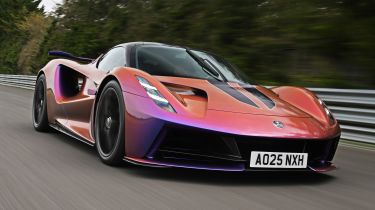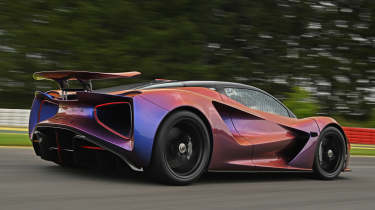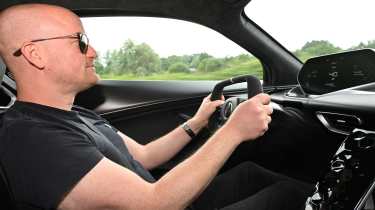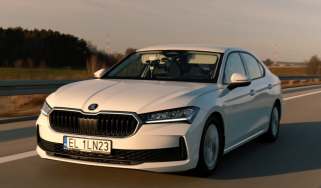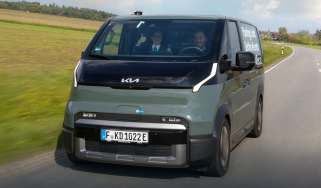Lotus Evija review: makes the Rimac Nevera seem slow
The new Lotus Evija boasts 2,011bhp and - as you'd expect - performance is staggering

Verdict
As a technical feat, the Lotus Evija is staggering. Straight-line performance is mind-altering, but the fact that all of its 2,011bhp is usable shows how much credit is due to the engineers who developed the feelsome chassis and the various electrical systems. The powertrain has genuine character and intensity, too, and the Evija has spectacular presence. The one question is whether wealthy customers will be willing to sink the best part of £2,000,000 into an EV when there are various hypercars with spine-tingling internal combustion engines.
Two thousand and eleven brake horsepower. That’s not a figure that we get to throw around very often on Auto Express. It’s more common on a review of a 100-foot yacht, perhaps, or a test drive of an earth mover.
But flat-out acceleration in a Lotus Evija doesn’t just make it feel like the earth is moving. It’s more like a jump into hyperspace. This is an all-electric hypercar operating in realms of straight-line speed well beyond the Aston Martin Valkyrie, and even fully electric alternatives like the Rimac Nevera.
Taking a look at the Evija’s immaculate production line gave us a glimpse of some of the incredible engineering that lifts the Evija to such a high level. A carbon-fibre tub forms the starting point and in true Lotus fashion, it’s lightweight: just 120kg. To this, beautifully crafted double-wishbone suspension is attached, above which sit the inboard coilover units. At the back, these will remain proudly on display behind a small window - where other hypercars might show a glimpse of their engines. Then there are the hydraulic actuators for the retractable rear wing; four of them are fitted, because two wouldn't be enough to cope with the 1,500kg of downforce that's produced at the car’s 217mph limited top speed - a figure that is made possible by the huge underfloor diffuser and dramatic airflow management through the car’s body. And all of this is thanks to the packaging of the electric powertrain; it wouldn’t be possible with a petrol engine.
Used - available now

2026 BMW
i4
45,861 milesAutomaticElectric
Cash £24,166
2023 Audi
e-tron
54,775 milesAutomaticElectric
Cash £16,517
2018 BMW
X4
62,127 milesAutomaticDiesel3.0L
Cash £15,344
2023 Hyundai
Santa Fe
27,114 milesAutomaticPetrol1.6L
Cash £31,136Where you’d normally expect an engine to be, the Evija has a 93kWh battery pack. Lotus toyed with the idea of mounting it under the floor, but that would have raised the floor height by 25cm – playing havoc with not only the seating position, but also the spectacular body design. Instead, it sits mid-mounted behind the front seats. It’s no lightweight at 740kg, but its location creates a 43:57 weight distribution. All-in, the Evija weighs 1,894kg – about the same as the BMW M4 – but each of the Evija’s motors produce about the same power as the M4’s straight six, and it has four of them. For a more hypercar-relevant comparison, the Ferrari F80 has a dry weight of 1,525kg, but has 894bhp less to play with.
The interior is a thing of beauty. A huge carbon-fibre wing spans the space between the windscreen pillars, giving a floating effect to the dashboard that allows light to fall into the footwells from above. The wing is dissected by a glossy spine that drops down to the floor, on which you’ll find functions such as the climate control and the starter button. It feels very pared back and minimalist – all very fitting with the brand’s lightweight ethos.
The view ahead is fantastic, with a low scuttle framed by those curving front arches uninterrupted by the tiny steering wheel that looks like it’s been squashed in a hydraulic press. It’s fantastic to hold, though, and the built-in keys for the indicators, headlights and wipers feel superbly intuitive. An enticing red dial adjusts among the five drive modes.
After a brief lap or two in City mode, with ‘only’ 1,000bhp and 800Nm to play with, we aim for the full 2,011bhp. We stop at the entry to the back straight on the track at the Lotus factory, engage Track mode to access full power, and floor the throttle pedal from a standstill.
Initially, the sensation isn’t that different to driving a really rapid electric car – yes, it’s hugely quick, but not so dramatic off the line. Keep your foot planted, though, and where every other EV tails off, the Evjia just keeps getting faster. The front motors are only able to begin to deploy their full power at around 100mph, at which point the steering wheel starts to wriggle in your hands as the front axle tries to cope with the torque going through it.
The result? Before we jumped on the phenomenally powerful 390mm carbon ceramic brakes, leaving plenty of room to make the hairpin, we touched roughly 170mph. In just 0.6 miles or so. Gavan Kershaw, the man responsible for developing so many iconic Lotus models over the last 30 years, including the Evija, reveals that on a flying lap he’s gone beyond 200mph on that stretch. Yikes. It’s mind-bendingly fast, forcing your brain to adjust to things your eyes and body can scarcely believe.
The official stats illustrate how that power is deployed. A 2.8-second 0-62mph time is very quick, but more eyebrow-raising is the 0-124mph time. At 5.77 seconds, it means that the Evija takes almost exactly the same time to cover 62-124mph as it does the first half. And it doesn’t let off much from there, because 0-186mph takes 9.97 seconds. For context, a Bugatti Chiron takes 13.6 seconds.
The Evija isn’t merely a drag race specialist, though - the rest of the package lives up to that monumental shove. Take the aforementioned brakes; adding to the lack of a gearbox and engine revs to help judge our speed, their huge stopping power meant that it takes some time to build up to just how late you step on that left pedal from the huge speeds. Unlike most other EVs, the Lotus has no regenerative braking; the company wanted to ensure that the feedback through the pedal remained as natural as possible.
But true to all the best Lotus models, the Evija is superb through the turns, too. It all feels fluid rather than blunt; there’s just a subtle hint of body roll to help you judge how the car is moving underneath you, delivering an extra dimension of feedback beyond its superbly feelsome steering.
That’s a result of Kershaw and his team making sure that the Evjia was rigorously tested without any of its stability and torque vectoring systems at first, to ensure that the car’s fundamental balance was right. That’s clear in the higher-speed corners where the grip and the stability are outstanding, while the tech presents itself more on the tighter stuff.
The open hairpin following the back straight is the perfect place to feel the end result; lean on the tyres until the front end just starts to reach its limits, and a gentle squeeze on the right pedal sees the motor driving the back rear tyre gently push the car through the understeer to help you slingshot onto the next straight. It’s so subtle that more often than not it feels like the systems are doing barely anything at all.
With my mind scrambled by its on-track pace, it was then time to head out onto the road. And amazingly for a 2,000bhp-plus hypercar, it feels really quite easy to live with. The ride has an obvious firm edge which jostles you around over larger bumps or when leaning on the brakes - there’s no denying you’re in a serious hypercar, yet it doesn’t shake your bones to the core. Think hot hatchback firmness but with more sophistication, and you aren’t too far off.
Soundproofing clearly wasn’t high on the agenda for Lotus engineers; the whine from the motors and transmission gives a fantastic mechanical connection to the car in a way that very few - if any - other EVs can, but you’ll also have to live with plenty of road noise, too. The sweet steering and superb forward visibility make the Evija a joy even when driving slowly, too.
Where you’d expect to find three mirrors in a normal car, here there are screens relaying images from cameras; having all three screens works much better than the mix of one or two screens with a conventional mirror that so many other cars use.
There are other ways in which the Evijva is seriously fast, too. It won’t be hard to zap through all of that energy, but it won’t take long to replenish it, either. The Lotus can accept a charge at up to a staggering 800kW - which will see its 92kWh battery replenished in just nine minutes. There is one slight snag, though - charges that quick don’t yet exist commercially. For now, owners will have to settle for 350kW, where a 0-80 per cent charge will take 12 minutes.
Did you know you can sell your car through Auto Express? We’ll help you get a great price and find a great deal on a new car, too.
| Model: | Lotus Evija |
| Price from: | £2 million (est) |
| Powertrain: | 4x e-motors, 93kWh battery |
| Power/torque: | 2,011bhp/1,704Nm |
| Transmission: | 2x single-speed, four-wheel drive |
| 0-62mph: | 2.8 seconds |
| Top speed: | 217mph (limited) |
| Range: | 195 miles |
| Charging: | 800kW |
| Size (L/W/H): | 4,459/2,000/1,122mm |
| On sale: | Now |

